Ron Ludekens
Mazzard Rootstock
Question: I Purchased a Early Ruby cherry yesterday. The sales clerk stated it was a mazzard root stock. Is this a f12-1 seedling or some other cultivar that is bacterial canker resistant. Gary
Answer: Gary,
The sales clerk is correct, the Early Ruby Cherry is on Mazzard rootstock. The Mazzard rootstock (Prunus avium) we are using is the seedling, not the F.12/1. It is still the number 1 choice for fruiting (and flowering) cherries although various semi-dwarfing rootstocks are being used commerically to increase orchard density and earlier fruiting (Colt, Geisela, Krymnsk and Maxma).
Fuyu (Jiro) Persimmon
Question: is a fuyu persimmons (jiro), the flat persimmons that can be eaten hard or when soft? Verena
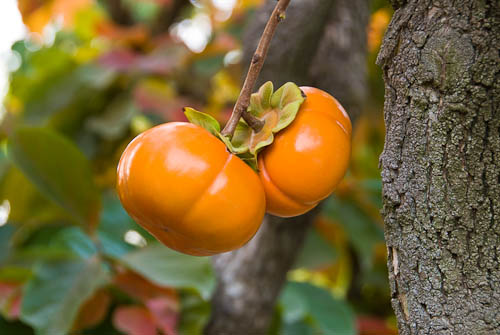
Fuyu (Jiro) Persimmon
Answer: Verena,
Yes the Fuyu (Jiro) is the most popular persimmon precisely for the reason that it is non-astringent and can be eaten right off the tree when it is hard. Other Non-astringent persimmons are the Fuyu (Imoto), Giant Fuyu (Gosho) and Izu.
The following are also non-astringent and can be eaten when properly cross pollinated and seeds inside: Chocolate when fully ripe, Maru, Nishimura Wase (nicknamed Coffeecake by others).
The following are astringent and used for cooking but can often be eaten when squishy soft: Hachiya, Saijo, Tamopan and Tanenashi.
Pruning 4-N-1 Apple Tree
Question: I just bought and planted an LE Cooke bare root apple from my local nursery. It is a 4in1 and is about 8 feet tall and beautifully branched. It was not pruned by my nursery and they advised me not to prune any of the main graft branches but only some of the side branches. I was under the impression that I should severely prune bare root trees upon planting. How should I prune this 4in1 for maximum success?
Thank you,
Paul
Answer: Paul,
Thank you for the complements on the 4-N-1 Trees. A lot of labor goes into those trees to make them nice - which (unfortunately) has to be reflected in the price paid for them. But that is a small price to pay for having fresh apples all season long from early summer to autumn . (More on 4-N-1 Apples can be read here)
. (More on 4-N-1 Apples can be read here)
I agree with you that bareroot trees should be pruned upon (or before) planting. How "severely" is a matter of debate or at least discussion. And that depends upon the type of fruit tree. Apples happen to be the most forgiving of all the trees we grow - it is hard to kill an apple tree accidentally. Others are not so forgiving.
The purpose of pruning is to help the tree survive the transplant. Digging a dormant tree removes a lot of root. The roots, when dormant, store the food that will feed the tree and provide the "push" to develop new leaves and new feeder roots. The roots also provide the water and nutrients when the leaves start to develop. If the top is too large and the roots have not had time to re-grow themselves to support the top, then the leaves will begin to transpire water and oxygen (part of photosynthesis) and the leaves will wilt since it cannot get enough water. If the top is reduced, it lessens that possibility. Then the newely established roots can support a smaller top.
How much to cut?
That depends upon the type of tree and how you want it to branch.
Your 4-N-1 Apple already has 4 main branches (one for each variety) that already dictates the main structure. I see no need to remove more than one third to one half of each branch. You might also want to clean out any branches that will be crossing the middle. Make your cuts above a bud where that bud points in a direction you want that future new branch to go.
Enjoy.
4-N-1 Apple Rootstock
Question: I bought a 4-in-1 mild climate apple (Anna, Red Fuji, Gordon, Golden Dorsett) but there is no rootstock info on tag. Can you tell what rootstock it is on?
Thanks,
Paul
Answer: Paul,
The 4-1N-1 Apples are grown on EMLA106 virus certified, semi-dwarfing apple rootstock. This rootstock produces a tree about half to two-thirds the size of a standard apple tree. It does not sucker and the rootstock is resistant to wooly aphid. EMLA 106 has been planted intensively in the East and West and is an excellent producer. We chose this rootstock knowing that most of these 4-N-1 trees will be planted in homeowner yards where space is at a premium. It should be planted on well drained soil as it is susceptible to crown rot.
Enjoy your apples!
What Are Chill Hours?
Question: What are "Chill Hours" on peach trees and what do you look for? I live in Delta, Colorado and we currently have peach trees and we are looking to increase our orchard by 4 or 5 dozen trees with some mid August to late August ripening. Which would you recommend? Darla
Answer: Chill hours - It is not really funny, but as I was starting to answer this, the whole mid and eastern section of the country is in the deepest freeze I have ever seen. That is not what we are talking about here.
Many deciduous plants and trees require a certain amount of winter/dormant chilling to properly set fruit or even flower. In its simplest definition, chilling hours are the number of more or less continuous hours under 45 degrees F. during the dormant period. Of course nothing is that simple since some days the temperature raises high enough to offset chilling that has previously occurred.
There are several theories how to calculate chilling hours and they can be reviewed in more detail here:
California Chilling Hours by Location
Why is this important? Some examples: Every one's favorite Elberta Peach needs approximately 800 chilling hours. It will not fruit in the coastal Los Angeles or Orange County area which only gets 200-500 hours of chilling. But the newer, equally delicious (L.E. Cooke discovered) Santa Barbara Peach will fruit (approx. 300 chilling hours). Popular Bartlett Pears require approximately 800 chilling hours. At one time there were vast orchards of Bartlett Pears in the San Jose region of California. As San Jose and Silicon Valley grew in population (and cement/asphalt), the winter chill was rasied and now we recommend other varieties for the area since Bartlett will not fruit consistently.
We grow in the richest agricultural area of the world and sufficient chilling hours has a lot to do with it. Although our Central Valley of California is rarely in a deep freeze, we often get a winter "Tule" fog that keeps the afternoon temperatures lower than if the sun were out. It is not uncommon to get 1,000 to 1,300 hours of winter chilling, allowing us to grow nearly anything and we usually do not get the hard spring freeze that does damage to young growth on the trees.
How do we determine chill hours for a variety? One way is to watch where it fruits and compare it to the number of recorded chill hours for that location. We depend a lot upon passionate fruit hobbyists like the California Rare Fruit Growers (CRFG) to take new varieties and plant them in their yards across the climate zones and report back their successes and failures. Often the chill hours are set high (we know it fruits here) and slowly lowered over the years as more experience dictates where it will fruit. For example, many Apples are labeled high chill - because they are grown in Eastern Washington and upstate New York and that was the extent of their testing. It took hobbyists to plant Fuji Apples in warm winter climates and discover they will fruit in areas with under 400 hours of chilling - a far cry from the 1,100 hours originally assigned to it.
In some stone fruits, like peaches and nectarines, you can compare bloom dates and determine chilling similarities from that. That is not true across all varieties.
Now that we discussed chill hours, let's answer your other question. Where you live, you do not have to worry about having enough chill hours - you have plenty! Your area of concern is hardiness to survive winter cold and late frosts that affect early blooms. Trees that bloom later in the spring are desirable to avoid damage to blossoms due to frost.
We have created "Recommended Variety Lists" for many places based upon climate. Another name for this page might be "Best Tasting" for that climate since our recommendations come from our favorite tasting fruit.
Here is a recommended variety list developed for our foothills which you might like to browse:Foothills List
And another one for colder areas:Cold Areas List
Fig Questions
Question: I have 2 questions:
1. what is the difference between brown turkey fig and improved brown turkey fig?
2. what is the difference between kadota fig and janice kadota fig?
Richard
Answer:
Richard,
1. We grow the "unimproved" Brown Turkey Fig which has been a popular, proven, tasty "heirloom" variety for hundreds of years and across a wide range of countries and climates.
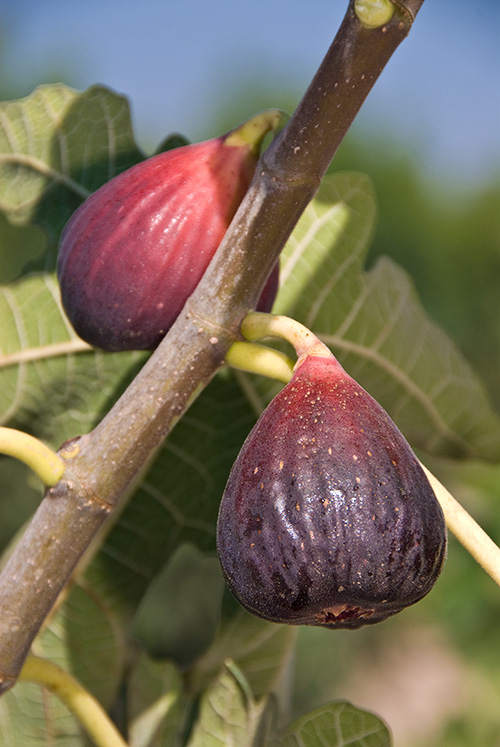
Brown Turkey Fig
I believe the "Improved" Brown Turkey Fig you mention is the same as Thompson's Improved Brown Turkey Fig and California Brown Turkey which has been around since the 1800s. According to Ira Condit, the proper name for this variety is San Piero. Here is what he says about it :
"The Thompson, or Thompson Improved Brown Turkey, is identical with San Piero. The same is true of Granata, grown by B. R. Amend, Portland, Oregon. The following account is based on trees in production at Riverside since 1930.
Trees are vigorous, precocious, very productive, often somewhat dwarfed by heavy crops; terminal buds violet-brown. Leaves medium to large, somewhat glossy above, variable as to lobing; some are 3-lobed, with upper sinuses shallow, others 5-lobed, with upper sinuses of medium depth, lower sinuses shallow; basal lobes commonly auricled (especially on leaves of sucker growth), with the borders overlapping; margins coarsely crenate.
Breba crop fair, stimulated by terminal-bud pruning of dormant twigs, as described by Hodgson (1925); figs large, up to 3-3/4 inches long and 2-1/2 inches in diameter, oblique-pyriform, sometimes elongated; average weight 105 grams; neck thick and short, merging gradually into body; stalk thick and short; ribs prominent, generally coloring earlier and deeper than body; eye large, open, scales tinted pink, even on immature fruit; white flecks numerous, variable in size; color greenish purple, darker on side exposed to sun and on the apex; bloom delicate, pruinose; meat violet; pulp strawberry; flavor rich; quality good. (Plate 24, A.)
Second-crop figs medium to large, or commonly very large on sucker wood of heavily pruned trees, obovate to oblique-pyriform; average weight 70 grams; neck variable, thick and short, or sometimes up to 1/2 inch long and curved; ribs prominent; eye large, open, scales purple; surface somewhat glossy, with prominent bloom; white flecks large, scattered, some elongated, violet at maturity; color purplish black, with lighter shades on neck; pulp strawberry, center hollow, as shown in plate 11 and by Condit (1941a, fig. 11, A); flavor fairly rich. Quality fair to good when matured on the tree. Consumed fresh; worthless for drying, on account of poor color and susceptibility to spoilage, therefore seldom grown in the San Joaquin Valley."
Here is a case where "Improved" may not be improved for everyone. I am not sure what is "Improved" about it. It does well at the coast but freezes easier and does not do well in typically great, hot fig climates like the San Joaquin Valley were we are located. On the other hand, the "unimproved" Brown Turkey that we grow has a wider climate range from the coast to inland heat and can go into colder climates.
2. The Janice Kadota Fig is a relatively new (Patented in 1991) fig that features a soft or non brittle endocarp (thus called "seedless" or nearly so). It came from a sport off a Kadota (White Kadota) Fig. Other than what I read on a Google search, I know very little about it. According to its patent paperwork, it might be a fraction of an inch larger that the White Kadota. At one time we grew and sold the Marylane Seedless Fig which was also a white, nearly seedless fig. We dropped it after many years since there was not much demad for it. I will have to look into adding that Janice Fig to our fig tree collection and evaluate it.
Grape Rootstock Question
Question: please tell me if your bare root and canned grape vines are grafted onto special rootstock or on their own roots?
thanks,
Ken
Answer:
Ken, we primarily grow for the homeowner market and not the commercial vineyards. The commercial orchards pay careful attention to soil profiles, disease and pest issues and high productivity for their location. Thus the added cost that more than doubles the grapevine price is worth it.
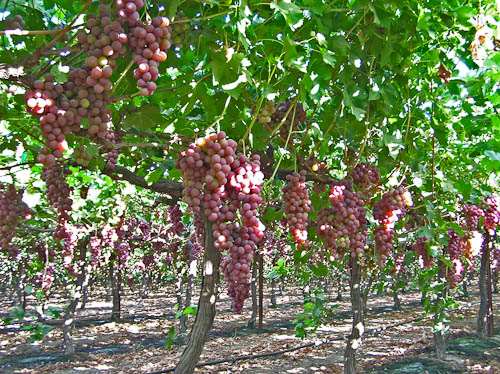
The homeowner on the other hand wants that back yard treat - fresh grapes picked at the peak of perfection, sweet and delicious. Some hobbyists might plant a small vineyard to enjoy the process of making their own wines or raisins. For the most part, the special rootstocks for our market would be meaningless and at best confusing. That is not to say that the special rootstocks would not be beneficial for some areas, it just really has little demand in our market.
Black Fruiting Mulberries for Cold Climates
Question: I live in Syracuse New York- the middle of the state, zone 5, heavy clay soil. I would like to grow Black Mulberries for the fruit. What is your thinking in terms of the black varieties you offer for my locale?
Regards, Jim
Answer: Jim,
It seems the popularity of fruiting mulberries continues to grow every year, and rightly so. The fruit can be delicious. What is a favorite food for people of Middle Eastern descent has been discovered by a wider population.
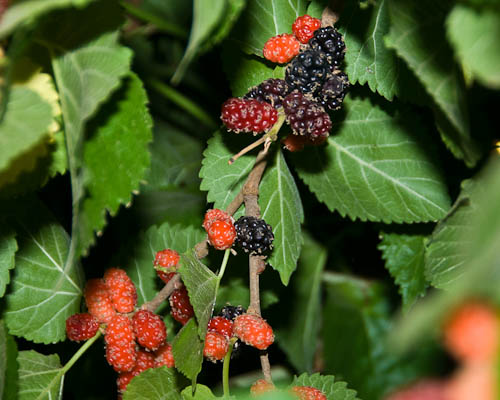
Black Beauty Mulberry fruit
There are two issues involved in answering your question. One is the cold hardiness of the tree and the other is the root system to handle the poor drainage of the clay soil.
All our Mulberries are grown or Morus alba tatarica - Russian Mulberry rootstock. It can handle cold to zone 3 and it has proven itself durable for most soil types. We ship mulberries throughout the Eastern states and tens of thousands of them into the Ontario, Canada area. I am confident it can handle normal clay.
The variety I know will grow and fruit for you is the Persian Fruiting Mulberry. It is cold hardy to USDA Zone 4. The Black Beauty Mulberry is a smaller tree also with excellent fruit. I do not have as wide a history of it as far as extreme climates. I am confident it will survive in Zone 5 and will probably go into zone 4 as well but do not have actual confirmation of that. Unfortunately, the Cooke's Pakistan with its huge 2"-3" tasty fruit will not survive in your winters. It will go in Zone 7 and maybe Zone 6 with some early year tip damage. Another alternative is the Teas Weeping Mulberry (Zone 3) which has small blackberry-like fruit. This tree is often used in formal landscapes because of its weeping shape.
Hope you enjoy your fruit!
Un-Fruiting Pomegranate
Question: Hello,
I planted an Angel Red pomegranate last spring. Now the leaves have all yellowed, dropped and there's still no fruit. We're in the San Gabriel valley, LA county.
Please advise. Janie
Answer: Hi Janie,
We started this nursery in San Gabriel back in 1944 and I spent my childhood there in the 50's & 60's so have fond memories of your area. We moved the nursery to Visalia in 1965-66.
I think you are asking if there a problem with yours. I am hoping that the yellowing / dropping leaves means it is going dormant as is normal for this time of year. We are a little colder here in Visalia and all the leaves have already dropped after turning yellow on our Angel Red Pomegranates.
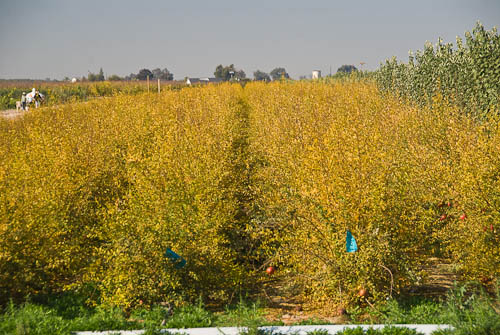
November 14 photo of Pomegranates going dormant
Assuming it is going to sleep for the winter, you can stop watering it until it leafs out next spring. Then you then should see new growth, orange-red blooms and fruit next year.
From your written question, I cannot make a definitive answer to whether you have a problem. Did you get new growth this year after you planted it? Any flowers? If you received no new growth, then I would be concerned about the health of the plant. Nurseries usually prune the pomegranate hard when transplanting them and it may be slow to get growing until the roots get re-established. Pomegranates are very water sensitive and the roots will rot if over-watered. They like desert-like climates. So, extra watering to "help it along" does not help at all and often hinders growth or kills the plant.
4-N-1 Combination Apples and Pears
4-N-1 Combination Fruit trees are popular - in spite of their cost. Let me tell you a little about the extra work that goes into making these premium trees.
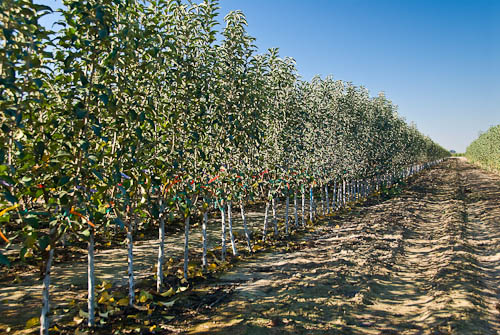
Here is a row of Cold Climate 4-N-1 Apples
First, you will notice they are widely spaced in the row. To get a well balanced head, we cannot plant them 6 to 9 inches apart.
There is care in where the buds are placed on the trunk of the tree. Different varieties grow at different speeds. Over time, we have fine tuned the placement of the buds.
For example, Red Delicious is a much slower grower than Yellow Delicious Apple. We put the Red Delicious bud at the top location on the west side because the top bud forces first in the spring and the west side gets the most sun during the growing season. Just the opposite for the fast growing Yellow Delicious - it is put at the bottom location on the east side of the tree. This care to detail has been done on every combination tree.
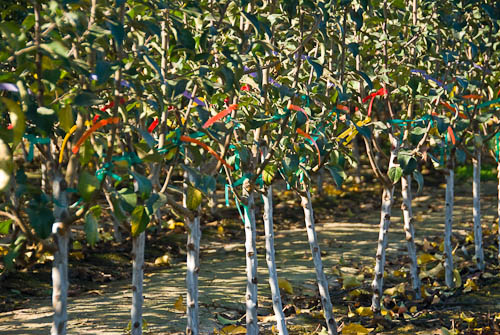
Each different variety is labeled prior to harvest so the customer knows what is on the tree. Another hidden cost is the number of trees that fail to make it to a sellable 4-N-1 or 3-N-1 tree. When budders get an average of 75% bud stand, statistics tell you that getting all four buds to take and grow on a tree is a challenge. And we throw away any combinations that are 2 varieties or less. So a lot of budding labor and seedling rootstock is planted that never makes it to sales.
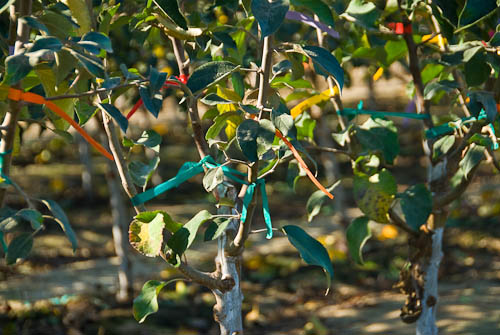
Notice how we train each branch to create a well balanced tree. On some limbs, as you see here, they are tied to pull up a branch that wants to grow outward instead of upwards. Other branches are tied to a stake in the ground to pull the branch down.
Is the cost worth it? Well, I sure enjoyed the 4 apple varieties that I trained as an espalier against my back fence.

